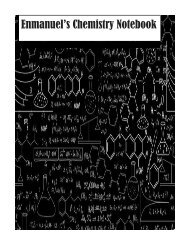You also want an ePaper? Increase the reach of your titles
YUMPU automatically turns print PDFs into web optimized ePapers that Google loves.
The Learning Goal for this assignment is:<br />
Stoichiometry and Balancing Reactions<br />
Stoichiometry is a section of chemistry that involves using relationships between reactants and/or<br />
products in a chemical reaction to determine desired quantitative data. In Greek, stoikhein means<br />
element and metron means measure, so stoichiometry literally translated means the measure of<br />
elements. In order to use stoichiometry to run calculations about chemical reactions, it is important to<br />
first understand the relationships that exist between products and reactants and why they exist, which<br />
require understanding how to balanced reactions.<br />
Balancing<br />
In chemistry, chemical reactions are frequently written as an equation, using chemical symbols. The<br />
reactants are displayed on the left side of the equation and the products are shown on the right, with<br />
the separation of either a single or double arrow that signifies the direction of the reaction. The<br />
significance of single and double arrow is important when discussing solubility constants, but we will<br />
not go into detail about it in this module. To balance an equation, it is necessary that there are the<br />
same number of atoms on the left side of the equation as the right. One can do this by raising the<br />
coefficients.<br />
Reactants to Products<br />
A chemical equation is like a recipe for a reaction so it displays all the ingredients or terms of a<br />
chemical reaction. It includes the elements, molecules, or ions in the reactants and in the products as<br />
well as their states, and the proportion for how much of each particle is create relative to one another,<br />
through the stoichiometric coefficient. The following equation demonstrates the typical format of a<br />
chemical equation:<br />
2Na(s) + 2HCl(aq) → 2NaCl(aq) + H2(g)<br />
In the above equation, the elements present in the reaction are represented by their chemical<br />
symbols. Based on the Law of Conservation of Mass, which states that matter is neither created nor<br />
destroyed in a chemical reaction, every chemical reaction has the same elements in its reactants and<br />
products, though the elements they are paired up with often change in a reaction. In this reaction,<br />
sodium (Na), hydrogen (H), and chloride (Cl) are the elements present in both reactants, so based on<br />
the law of conservation of mass, they are also present on the product side of the equations.<br />
Displaying each element is important when using the chemical equation to convert between<br />
elements.<br />
Stoichiometric Coefficients<br />
In a balanced reaction, both sides of the equation have the same number of elements. The<br />
stoichiometric coefficient is the number written in front of atoms, ion and molecules in a chemical<br />
reaction to balance the number of each element on both the reactant and product sides of the<br />
equation. These stoichiometric coefficients are useful since they establish the mole ratio between<br />
reactants and products. In the balanced equation:<br />
2Na(s)+2HCl(aq)→2NaCl(aq)+H2(g)




